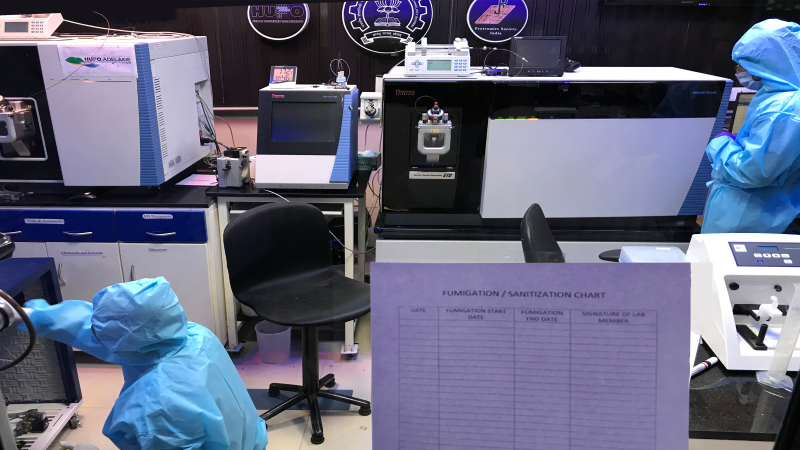
Image Credit: IIT Bombay
India’s Covid-19 cases saw a massive surge in March and April 2021. The second wave of the Covid-19 pandemic put a lot of pressure on the medical infrastructure. Appropriate medical facilities were at times not available to those who needed them most—the ones who had severe symptoms. There was no way to predict how severe the symptoms of an infected person could become. The golden test to check for Covid-19, the RT-PCR test can only tell whether a person is infected or not. Unfortunately, the test cannot determine the severity of the infection.
Researchers from the Indian Institute for Technology Bombay (IIT Bombay) and Kasturba Hospital for Infectious Diseases, Mumbai, led by Prof Sanjeeva Srivastava of IIT Bombay, have found that levels of specific proteins in the nasopharyngeal samples of a person can differentiate between low and high severity of infection. This information would help hospitals distribute healthcare resources on time and ensure that those who require critical care could be identified with relative ease. The study was published in iScience, an open-access journal from Cell Press. The study was funded by the Council of Scientific & Industrial Research (CSIR) and by IIT Bombay.
The commonly used RT-PCR test uses a reverse transcription-polymerase chain reaction to detect the virus’s nucleic acid. But specific viral or host proteins, released at different stages of infection, have stories to tell. By identifying which protein is released at which stage, we can determine the severity of the disease. Mass spectrometry is a tool that can find if a particular protein is present and in what percentage in a sample.
But first, the researchers needed to check if mass spectrometry could be used as a primary diagnostic test to confirm Covid-19 infection. Separate tests for detecting and measuring the severity of Covid-19 would only increase the work of the already burdened medical staff. The researchers collected nasopharyngeal samples from three groups of patients; Covid-19 positive, Covid-19 negative and Covid-19 recovered. They used mass spectrometry to determine which proteins were present in each of the groups’ samples.
The researchers compared the protein profiles of Covid-19 positive and Covid-19 negative samples. They identified 25 proteins that were upregulated or present in higher quantities in Covid positive patients. They verified the 25 proteins’ identities and quantities using a mass spectrometry technique called the Selected Reaction Monitoring (SRM) assay. While mass spectrometry can identify any biomolecule, an SRM assay is targeted at just proteins. Therefore, SRM is a highly sensitive and selective method for the identification of proteins and the precise measurement of their quantities.
These 25 proteins could potentially be used to determine whether a sample is Covid positive or Covid negative. A quantitative clinical study on a larger cohort needs to be done to determine the cutoff percentages of the identified proteins. It would allow mass spectrometry to be used as a diagnostic test.
The researchers used Covid-19 recovered samples to identify whether these proteins also indicated progression towards severity or recovery. Thus, Covid-19 recovered patients were used as another control to narrow down the list of significant proteins that were altered only in the positive patients.
The second step was to find proteins that differentiated severe cases from non-severe ones. The 24 Covid-19 positive samples consisted of 11 non-severe and 13 severe patient samples. A patient is said to have high severity if they have acute respiratory distress syndrome, pneumonia or an oxygen saturation level below 87%. The researchers analysed the samples of the severe and non-severe groups separately. They identified six significant proteins that could differentiate severe Covid-19 patients from non-severe ones.
Proteins take part in cellular activities through step-by-step processes. Each step of a process may require particular proteins. The researchers studied the role that the six identified proteins played in the cellular processes in humans. A Covid-19 infection alters these processes, leading to higher levels of the six identified proteins. Thus, creating drugs that inhibit the significant proteins would lower the severity of the infection.
The researchers wanted to check if any existing drugs could be used to target the identified proteins rather than waiting for a new drug to be designed. The advantage of using existing drugs is that they are verified for safety. In the lab, the researchers investigated the binding efficiency of current drugs (29 FDA-approved, nine clinical, and 20 pre-clinical trial drugs) to the proteins involved in altered cellular processes in the infected host. By doing this, the researchers identified several drug candidates and small molecules, which could potentially bind to and inhibit the significant proteins.
“Drug development is a costly and time-consuming process. Thus it is important to find an alternative therapeutic approach for dealing with Covid-19,” explains Dr Kruthi, one of the authors of the study. “Most of these drugs are FDA approved and are in use for combating other groups of diseases. Thus, these drugs have the potential for Covid-19 therapy.”
Mass spectrometry could potentially be used as a diagnostic and prognostic test. Further studies on a large cohort of Covid-19 positive and Covid-19 negative samples in order to validate these results need to be done. A quantitative analysis of the identified proteins needs to be conducted. Further tests inside human cells need to be done to validate these small molecules and drug candidates.
This article has been run past the researchers, whose work is covered, to ensure accuracy.






